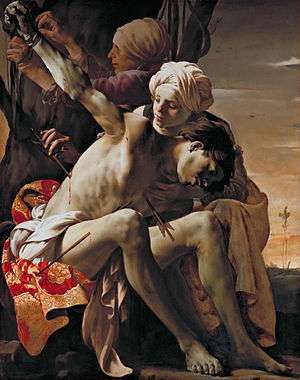Castulus
| Saint Castulas | |
|---|---|
 St. Castulus statue at Moosburg | |
| Martyr | |
| Died |
286 AD Rome |
| Venerated in | Roman Catholic Church, Eastern Orthodox Church |
| Feast |
Roman Catholic Church: March 26; March 27 (Freising, Munich). Eastern Orthodox Church: December 18[1] |
| Attributes | spade. |
| Patronage | Shepherds; invoked against erysipelas, lightning, horse theft, wildfires, drowning, cowherds[2] |
Saint Castulus (died 286) is venerated as a martyr. According to tradition, he was the chamberlain (or officer, valet) of Emperor Diocletian and the husband of Irene of Rome, also venerated as a saint.[2]
Biography
A convert to the Christian religion, he sheltered Christians in his home and arranged for religious services inside the palace of the emperor. Among those he sheltered were Mark and Marcellian.[3] He is one of the saints associated with the life and legend of Saint Sebastian.
With his friend Saint Tiburtius, he converted many men and woman to Christianity and brought them to Pope Saint Caius to be baptized.[4] He was betrayed by an apostate named Torquatus and taken before Fabian, prefect of the city.[4]
Castulus was tortured and executed by being buried alive in a sand pit on the Via Labicana. According to tradition, Irene subsequently buried the body of the martyred Sebastian. She was later martyred herself, around 288 AD.
Veneration of St. Castulus
A church dedicated to him at Rome, built on the site of his martyrdom, existed from at least the seventh century.
Castulus was venerated in Bavaria after relics of his were taken to Moosburg. Duke Heinrich der Löwe started the construction of the Kastulus Minster (cathedral) in 1171.
In 1604, relics were also brought to Landshut.[2] His relics still rest in Landshut's church of St. Martin's.
| Saint Irene of Rome | |
|---|---|
|
St Sebastian Tended by Irene and her Maid. Hendrick Ter Brugghen | |
| Died |
288 AD Rome |
| Venerated in | Roman Catholic Church |
| Feast | January 22 |
| Attributes | tending to Saint Sebastian. |
Veneration of St. Irene of Rome
_01.jpg)
Irene of Rome was the widow of the martyr St. Castulus. After the death of her husband, she continued to be active in the Christian community in Rome. According to legend, when Saint Sebastian was discovered to be a Christian, in 286, he was handed over to the Mauretanian archers, who tied him to a tree and pierced him with arrows.[5]
However, Irene came to bury the body and found that he was not quite dead. Irene took him to her lodgings and nursed him back to health. Irene is venerated by Christians for her virtuous care in attending the injured.
Her feast day is March 30.
St. Irene tending St. Sebastian was the subject of paintings by Benedetto Luti and others.
-

Irene of Rome and Saint Sebastian
-

Trophime Bigot
-

Dirck van Baburen, 1615
-

Marcantonio Bassetti -c.1620
-

attributed to Georges de La Tour, early 1630s
-

Georges de La Tour 1650
-

Felice Ficherelli -1650
-
Vicente López Y Portaña 1795-1800
Notes
- ↑ Saints, December 18, Justin Popović (Serbian)
- 1 2 3 Name bedeutet: der Gewissenhafte (latein.) (2007-03-25). "Castulus (Kastulus) - Ökumenisches Heiligenlexikon". Heiligenlexikon.de. Retrieved 2011-06-27.
- ↑ Ebenezer Cobham Brewer, A Dictionary of Miracles: Imitative, Realistic, and Dogmatic (Chatto and Windus, 1901), 11.
- 1 2 "Santos". ACI Prensa. 2007-07-29. Retrieved 2011-06-27.
- ↑ Löffler, Klemens. "St. Sebastian." The Catholic Encyclopedia. Vol. 13. New York: Robert Appleton Company, 1912. 8 Jan. 2013
External links
- St. Castulus
- (German) Castulus (Kastulus)
- (Czech) SV. HAŠTAL (KASTUL)
- (Spanish) San Castulo, Mártir
